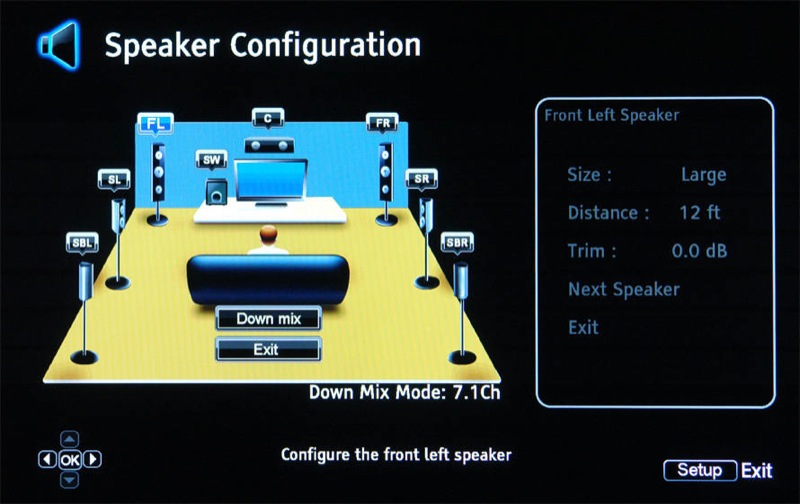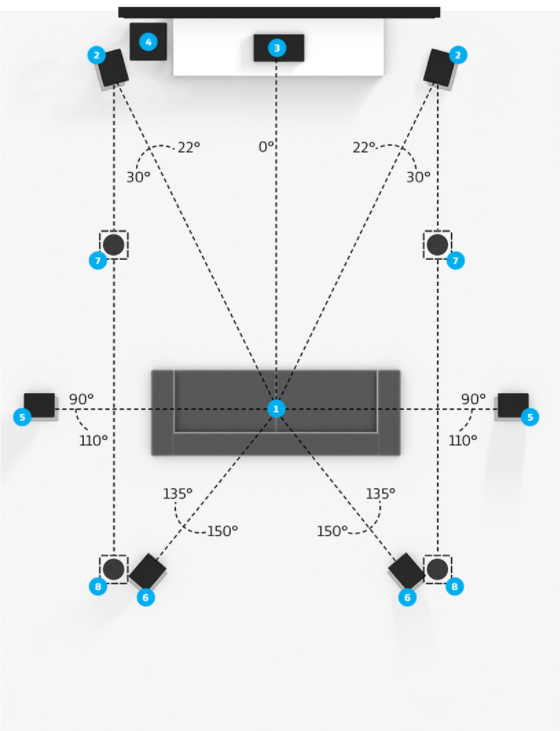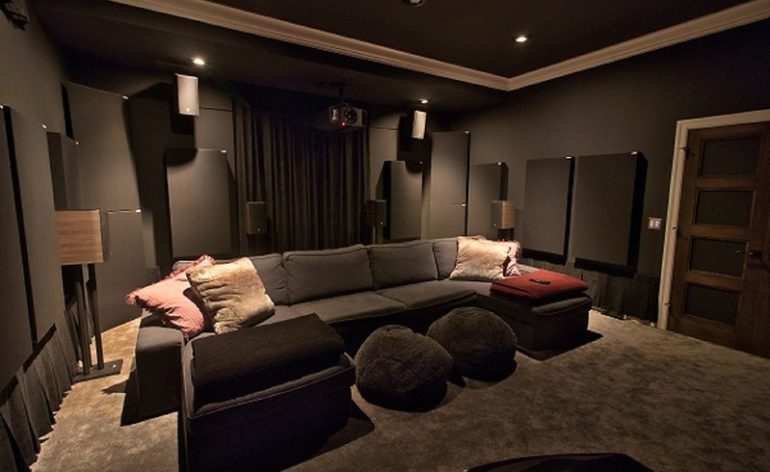Positioning Surround and Atmos Speakers
In a recent article, we talked about off-axis speaker response and how to position your front left and right speakers. We alluded to the other speakers in your home theater, but we didn’t directly address how to position them. Let’s rectify that now. So, how do you position surround and Atmos speakers?
Positioning Your Side Surround Speakers
Surround speakers have two forms – side surrounds and surround backs. Regardless of what Dolby might say these days, originally the recommendation was that your side surround left and right speakers be slightly behind you on the sidewalls and positioned up fairly high. Nowadays they say they’ve always suggested that they be directly to your sides. That’s not true and we don’t care how you’ve tried to scrub that info off your website. We have the Wayback Machine and we’re not afraid to use it.

When walking through the setup on your AV receiver, you may see a graphic like the one above. You should not take these as some sort of example of where to put your speakers. Instead, they are created to best display the individual channels, not where they should actually live in your room. I mean, the side surrounds look like they are in front of the couch. Don’t do that.
The surround left and right speakers should be positioned directly to the left and right of your couch (or main row of seats) in line with your head when you are seated (don’t forget to factor in any recline). They should be high enough so that the tweeter on the speaker has a direct line-of-sight to every ear on the couch. So the left surround speaker should be able to “see” the right ear of the person sitting all the way on the other side of the couch. The same for the right surround.
The speakers should be placed so that they are firing straight forward. They should NOT be angled toward the center of the couch. The surround effects are supposed to be slightly more diffuse. There is no need to angle the speakers.
Positioning Your Surround Back Speakers
Your surround back speakers are a little different than your surround speakers. Before you place these speakers, you need to know the location of your front left and right speakers. Once you know that, the surround back speakers should be placed on the back wall, directly across from the corresponding front speaker. So, the front left and surround back left should be looking at each other. The front right and the surround back right speaker should be in line. The below image, from a Denon receiver manual, is pretty accurate if you ignore how the surround speakers are pointed directly at the listener.

Like the side surrounds, the surround back speakers should be positioned so that they are firing directly into the room (toward the front wall). There are a lot of reasons for this not the least of which is that you aren’t facing those speakers. Your ears just aren’t that sensitive to sounds that are coming from behind you. Aiming the speakers toward you, or trying to get perfect imaging, just isn’t effective for sounds coming behind you. Throw them on the back wall and just make sure they are pointed into the room.
Like the side surrounds, the surround backs should be high enough to “see” every listener’s head. This means they need to be high enough to clear the top of the couch. If you have high-backed chairs, that could position your surround back speakers fairly high. Again, don’t worry about aiming them at your seat. You won’t notice the difference anyhow.
Positioning Your Atmos Speakers
Atmos speakers usually go on your ceiling. Atmos was designed with in-ceiling speakers in mind. There are a couple of overhead options you can choose from with dolby giving you some placement options based on angles. Depending on the layout of your room and the height of your ceiling, you may opt for one layout over another. That’s not what we will be discussing here.
Again, you’ll need to know the location of your front speakers to know where you place your Atmos speakers. Your front, surround back, and Atmos speakers should all be in a line. The graphic below from Dolby is a pretty accurate representation of how a 7.1.4 Atmos configuration should be set up (again, ignore the angling of the speakers).

When you see the labeled angles of the speakers, those aren’t the angles the speakers can be aimed, they are where the speakers should be positioned in the room. So, for the front speakers they should, according to Dolby, live 22 to 30 degrees from your seated position. The amount of toe-in you apply to the front speakers will be determined by the performance of the speaker, not Dolby.
When positioning Atmos speakers, remember that your ears aren’t as sensitive to sounds coming from above you as in front. Dolby designed Atmos with in-ceiling speakers in mind. If you use something else like an on-ceiling speaker, point it directly down. The Atmos effects don’t require the speakers to be aimed at your seat. Spending extra money on adjustable mounts or angled in-ceiling speakers would be a waste.
Space Between Surround and Atmos Speakers
Unfortunately in the Atmos graphic above, Dolby has the surround back and rear Atmos speakers basically on top of each other. Our rule of thumb is that speakers should have at least five feet of physical space between them. This gives them enough room so that the sound they create doesn’t confuse your ear. All we can think is that the room Dolby was using in the graphic was VERY tall.
Conclusion
When positioning surround and Atmos speakers, the graphics that are provided by most companies can be very confusing. The key thing to remember is that most of the speakers in your home theater should be pointed directly into the room and not aimed at your seat. By properly placing and positioning your surround and Atmos speakers, you’ll experience the proper surround effects.



That was useful. Thank you.